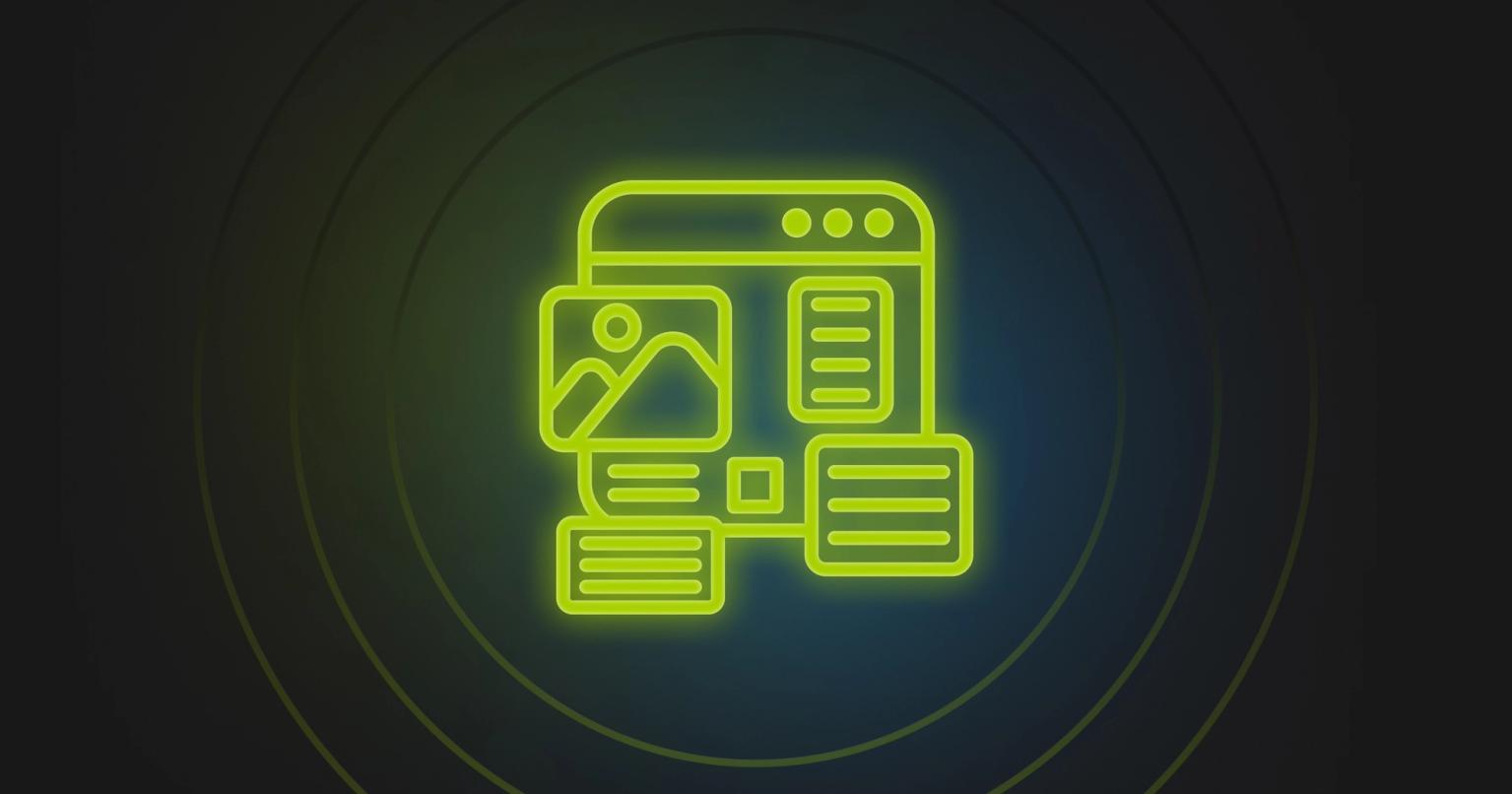AI & Examples of Human-in-the-Loop in Marketing

Summary
Explore real-world ways human-in-the-loop AI helps marketing teams create, personalize, and optimize with confidence.
Here's something that might surprise you: if you've used ChatGPT or Claude to draft an email, refine some copy, or brainstorm campaign ideas, you've already experienced human-in-the-loop AI.
That back-and-forth process where you prompt, review the output, give feedback, and iterate until it's right? That's human-in-the-loop (HITL) in action. The AI generates content at scale, you apply judgment and brand knowledge, and together you produce something better than either could alone.
The difference between what you're doing individually and what enterprises are building at scale isn't some massive leap in complexity. It's about taking that same collaborative dynamic and applying it systematically across your marketing operations.
The delta between cool and brand-ready AI use cases
There's a critical gap most companies don't account for when thinking about AI in marketing. On one side, you have AI that shows potential. It's cool, it's fast, it generates interesting ideas. On the other side, you have AI that's good enough to pass your internal brand guidelines and quality standards.
That delta is where human-in-the-loop becomes essential.
ChatGPT can write a decent blog post. Can it write one that matches your brand voice, incorporates your messaging framework, and threads in the subtle positioning that differentiates you from competitors? Not without human guidance. AI can generate dozens of email subject lines. Can it pick the one that balances urgency with authenticity for your specific audience? Not without human judgment.
The teams winning with AI aren't the ones with the fanciest technology stack. They're the ones with clean foundations: organized marketing operations, clear design systems, good data hygiene, and teams trained to collaborate with AI effectively. They're treating this as an experiment worth committing to, not a silver bullet that works out of the box.
Let's look at how this plays out across different marketing disciplines.
Content creation
Your content team needs to produce blog posts, social copy, and campaign messaging at scale. The traditional bottleneck is the time it takes to research, draft, and refine each piece. AI can accelerate the research and initial drafting, but the gap between an AI-generated first draft and publishable content is where most teams struggle.
AI-generated content often lacks the nuance and emotional resonance that makes content memorable. It can sound generic or miss subtle brand positioning. The workflow that works is having a marketing strategist provide the AI with a detailed content brief, target keywords, and brand voice guidelines. The AI generates the first draft based on research and parameters. Then a content lead reviews for accuracy and brand alignment, the AI refines specific sections based on feedback, and an editor polishes tone while adding unique insights and examples that only a human would know to include.
The output is content produced faster because AI handles research and structure, while maintaining the quality bar your brand requires. Editors infuse creativity, strategic messaging, and context the AI couldn't access. They catch when the AI uses competitor framing or misses an opportunity to differentiate. They add the 10% that makes the content truly engaging.
Workflow:
- Marketing strategist provides AI with content brief, target keywords, and brand voice guidelines
- AI generates first draft based on research and parameters
- Content lead reviews for accuracy, brand alignment, and messaging
- AI refines specific sections based on feedback
- Editor polishes tone, adds unique insights and examples
- Final human approval before publishing
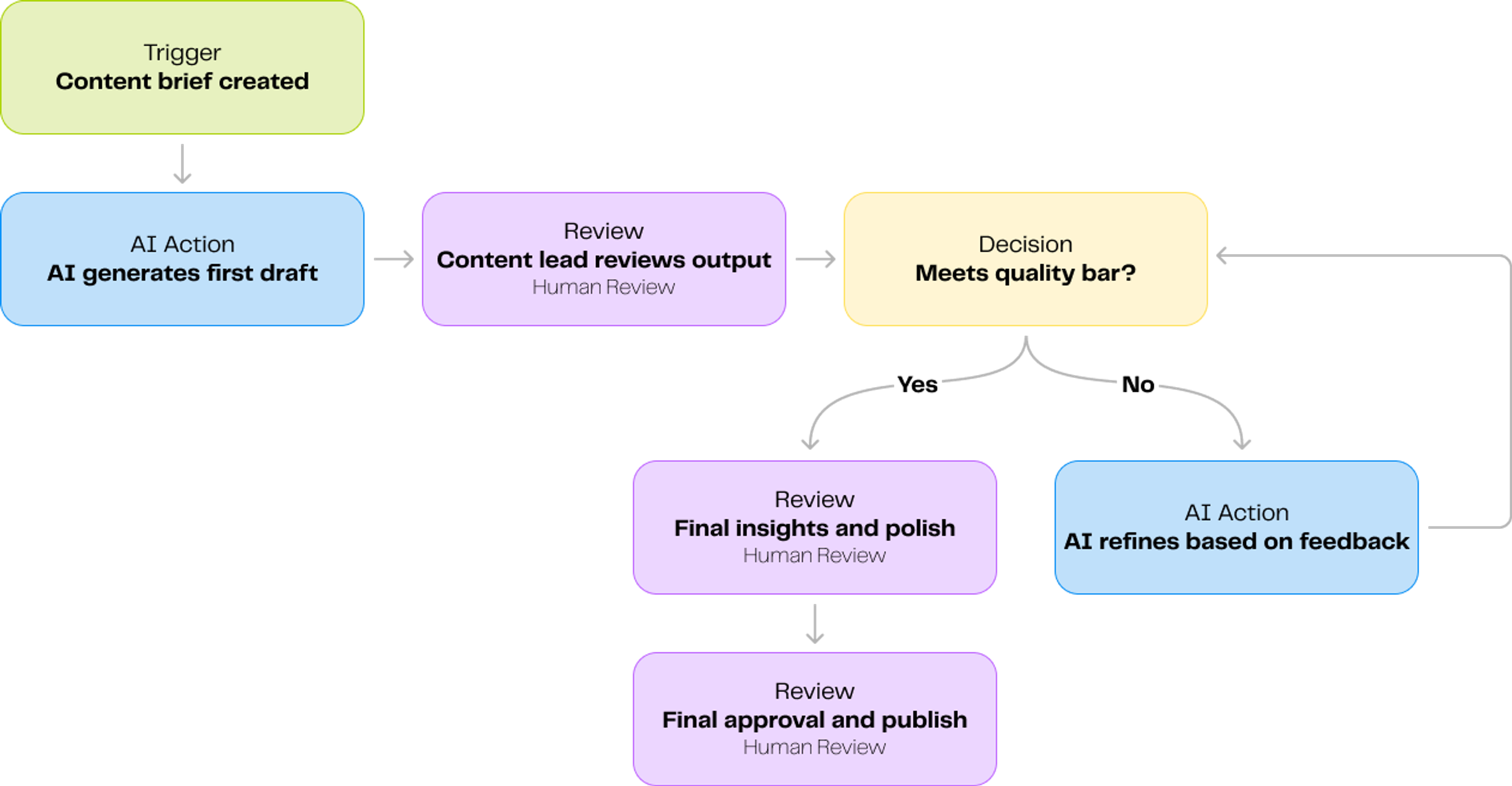
Email marketing
You're launching a campaign with multiple audience segments, each needing tailored messaging. The challenge is creating personalized content at scale without sacrificing the brand voice that makes your emails recognizable and trustworthy. AI can generate variations quickly, but picking the right ones requires understanding your audience in ways that go beyond data.
The email team defines campaign goals and audience segments first. AI generates subject line variations and body copy options for each segment. The marketing ops team reviews suggestions, selecting top performers based on brand fit, not just predicted open rates. AI creates A/B test variants, but humans approve final selections and set test parameters. After the campaign runs, humans analyze results and feed insights back to the AI for the next campaign.
This creates a continuous improvement loop. Each campaign teaches the AI more about what works for your brand and audience. Over time, suggestions get sharper because humans are consistently providing feedback. The marketing team curates AI outputs, tweaking language to match brand voice and selecting options that balance performance optimization with authenticity. They also interpret test results in context, understanding why something worked goes beyond the metrics.
Workflow:
- Email team defines campaign goals and audience segments
- AI generates subject line variations and body copy options for each segment
- Marketing ops reviews suggestions, selecting top performers based on brand fit
- AI creates A/B test variants
- Human team approves final selections and sets test parameters
- Post-campaign, humans analyze results and feed insights back to AI for next campaign
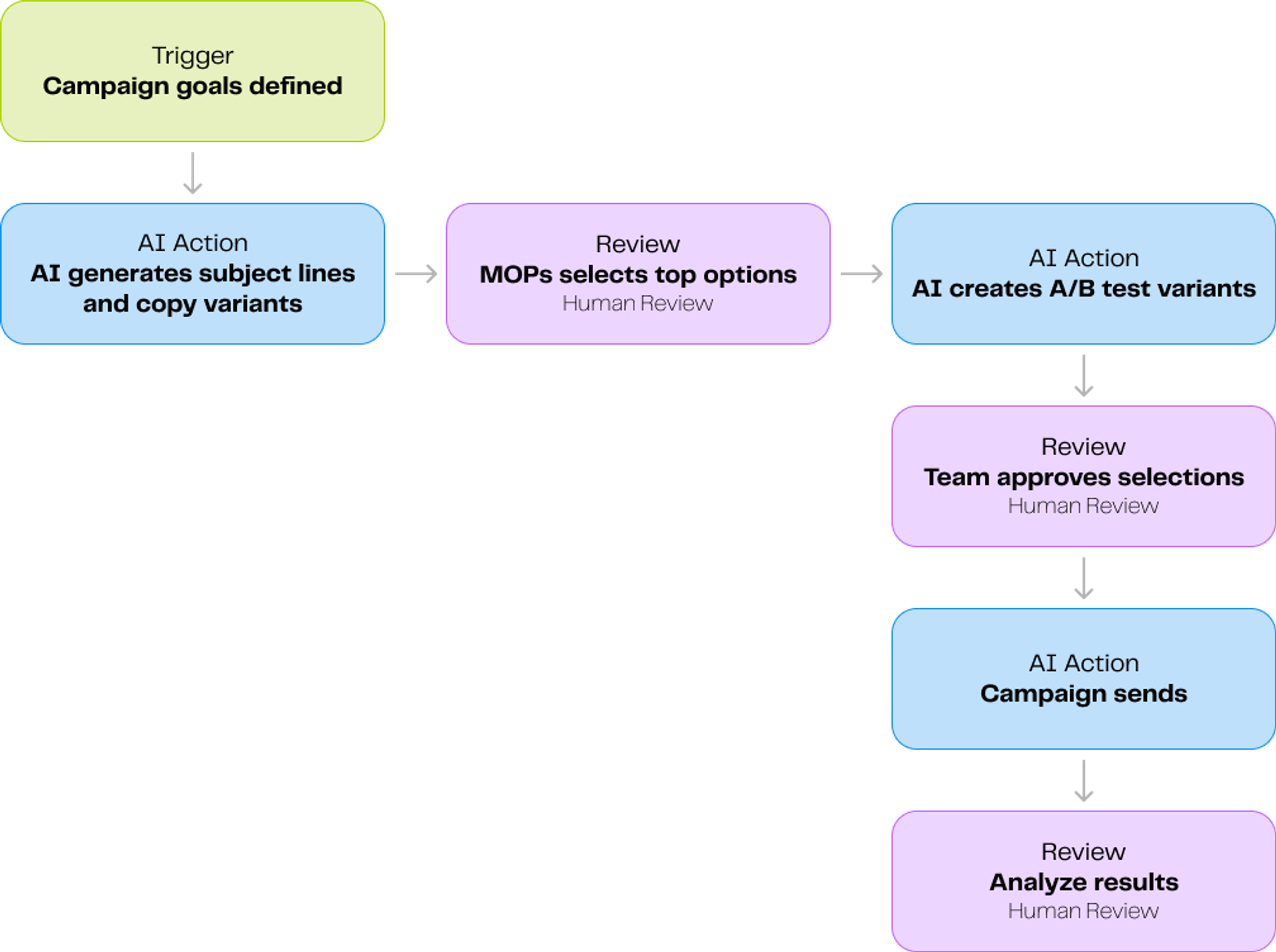
Design and creative production
You need to create campaign assets across multiple formats, markets, and channels. The production workload is massive, and traditional processes can't keep up with the demand for localized, personalized creative at scale. AI can replicate visual patterns and generate variations, but it struggles with creative judgment: knowing when to break the rules for impact, understanding cultural context, or adding that unexpected element that makes design memorable.
A designer creates the master campaign concept and visual direction. AI learns brand style rules and generates variations for different sizes, formats, and localizations. The design team reviews AI-generated assets, and designers make adjustments for cultural nuances or creative flair that the AI couldn't anticipate. An art director approves only the assets that meet brand standards before deployment across channels.
Designers remain the creative decision-makers throughout this process. They teach the AI by example, set the quality bar, and handle the parts that require artistic judgment. The AI doesn't replace creativity. It handles the production work that lets designers focus on actual design. This approach allows teams to scale creative output without adding headcount, while maintaining the level of craft and attention that defines their brand.
Workflow:
- Designer creates master campaign concept and visual direction
- AI learns brand style rules and generates variations (different sizes, formats, localizations)
- Design team reviews AI-generated assets
- Designers make adjustments for cultural nuances or creative flair
- Art director approves assets that meet brand standards
- Approved variations are deployed across channels
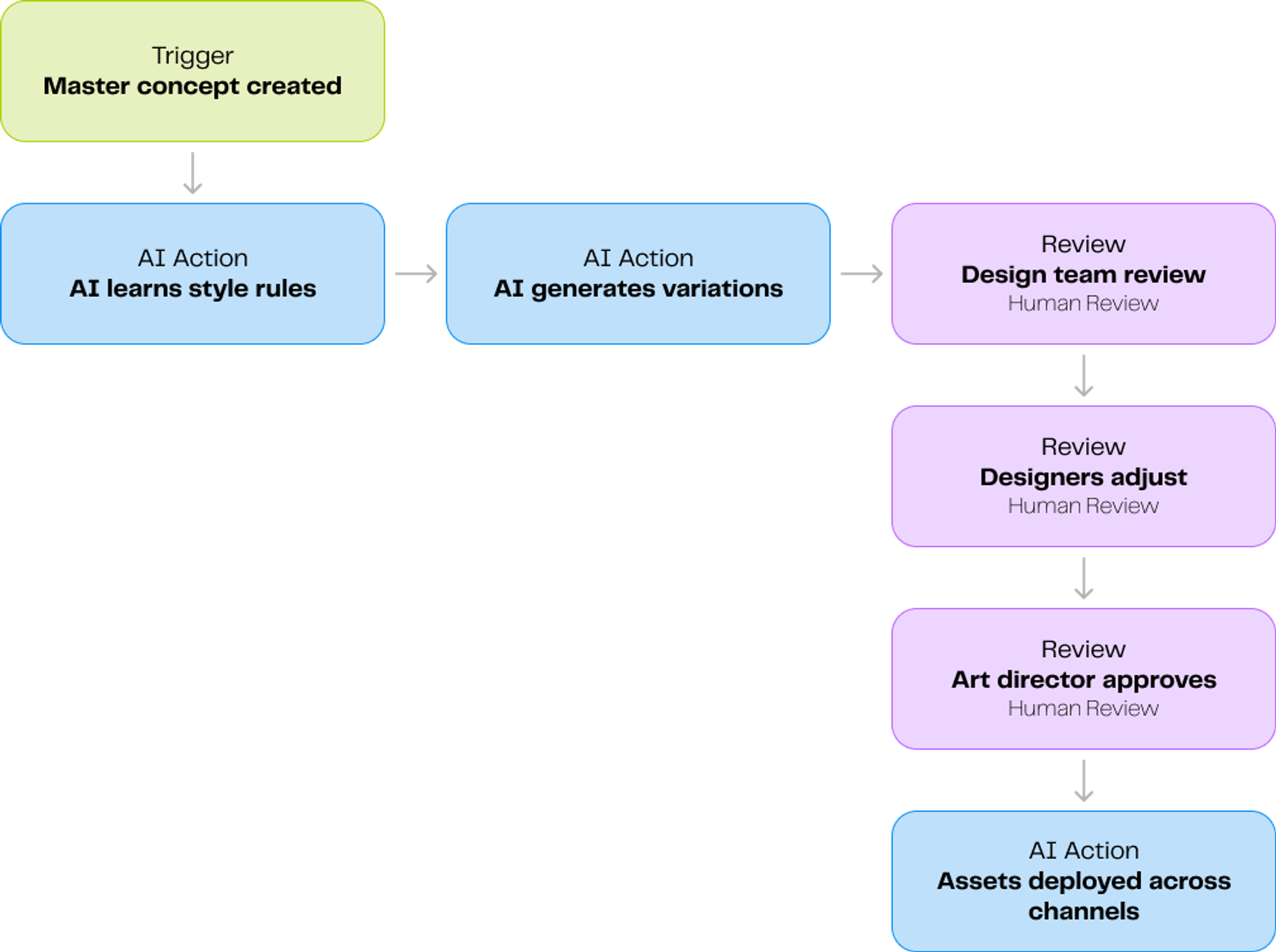
Personalization
You want to deliver personalized experiences to customers based on behavior and preferences. The volume of data makes it impossible for humans to manually analyze and act on every signal. AI can process this data and spot patterns, but it can't always distinguish between correlation and causation. It might make recommendations that are technically accurate but strategically off-brand or ethically questionable.
The marketing team defines personalization goals and segments first. AI analyzes customer data to identify patterns and opportunities. Data scientists validate AI insights and recommendations, checking for bias or logical gaps. The marketing team then creates personalized content templates and offers that feel helpful rather than creepy. AI delivers personalized variations to each customer, but the team monitors results continuously and adjusts strategy based on performance and customer feedback.
Marketing strategists set the parameters for what the AI should optimize, interpret the insights in business context, and design the actual customer experiences. They make sure personalization aligns with brand values and doesn't cross lines that could erode customer trust. The result is one-to-one marketing at scale that still feels authentic because humans are curating the AI's actions.
Workflow:
- Marketing team defines personalization goals and segments
- AI analyzes customer data to identify patterns and opportunities
- Data scientists validate AI insights and recommendations
- Marketing team creates personalized content templates and offers
- AI delivers personalized variations to each customer
- Team monitors results and adjusts strategy based on performance
Social media listening
You need to monitor conversations, spot trends, and engage with your audience across platforms. The volume of mentions and comments makes it impossible to read everything manually, but automated responses risk feeling robotic or tone-deaf. AI can categorize sentiment, but it often misses sarcasm, cultural context, or the nuance that determines whether a comment is actually negative.
AI monitors social channels for mentions, sentiment, and emerging trends. The system flags important conversations and insights for human review. Community managers assess context and decide on appropriate responses. For trending topics, the marketing team develops a response strategy. Humans craft and approve all public-facing responses. AI tracks engagement and surfaces insights for future campaigns.
This gives you the speed of AI analysis with the authenticity of human engagement. You don't miss important conversations buried in thousands of comments, but you also don't auto-respond in ways that could damage your brand. Community managers apply judgment to every interaction, making sure responses feel authentic and appropriate. They catch opportunities the AI might flag as issues, or vice versa, and make strategic decisions about when and how to engage.
Workflow:
- AI monitors social channels for mentions, sentiment, and emerging trends
- System flags important conversations and insights for human review
- Community managers assess context and decide on appropriate responses
- For trending topics, marketing team develops response strategy
- Humans craft and approve all public-facing responses
- AI tracks engagement and surfaces insights for future campaigns
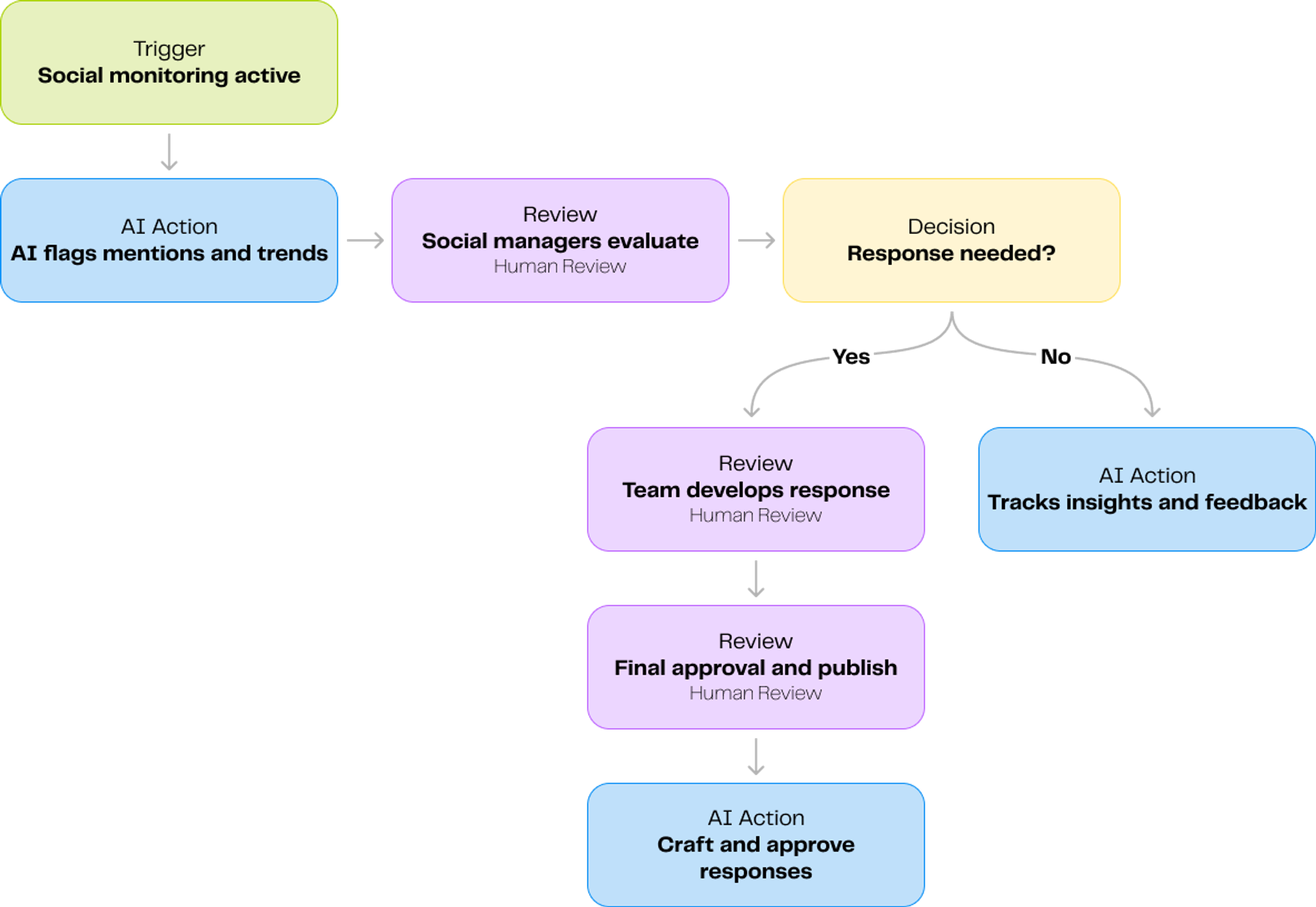
Analytics and insights
You need to understand campaign performance and identify opportunities for optimization. The amount of data makes manual analysis time-consuming and prone to missing patterns. AI can surface correlations that aren't meaningful or miss context that explains apparent anomalies. It might recommend changes that ignore seasonality, competitive dynamics, or upcoming business initiatives.
AI processes campaign data and identifies patterns. The system flags anomalies and potential insights automatically. Analysts validate findings and investigate causation, bringing domain expertise and business context to interpret what the data actually means. The team interprets results in business context, and strategists develop recommendations based on insights. Humans make final decisions on campaign adjustments.
Analysts ask questions the AI wouldn't know to consider and connect insights back to strategy. They turn patterns into actionable recommendations that account for factors the AI can't see in the data alone. This is where AI saves massive amounts of time without replacing human judgment. Instead of manually combing through reports, analysts focus on interpretation and strategy, the parts that actually drive decisions.
Workflow:
- AI processes campaign data and identifies patterns
- System flags anomalies and potential insights
- Analysts validate findings and investigate causation
- Team interprets results in business context
- Strategists develop recommendations based on insights
- Humans make final decisions on campaign adjustments
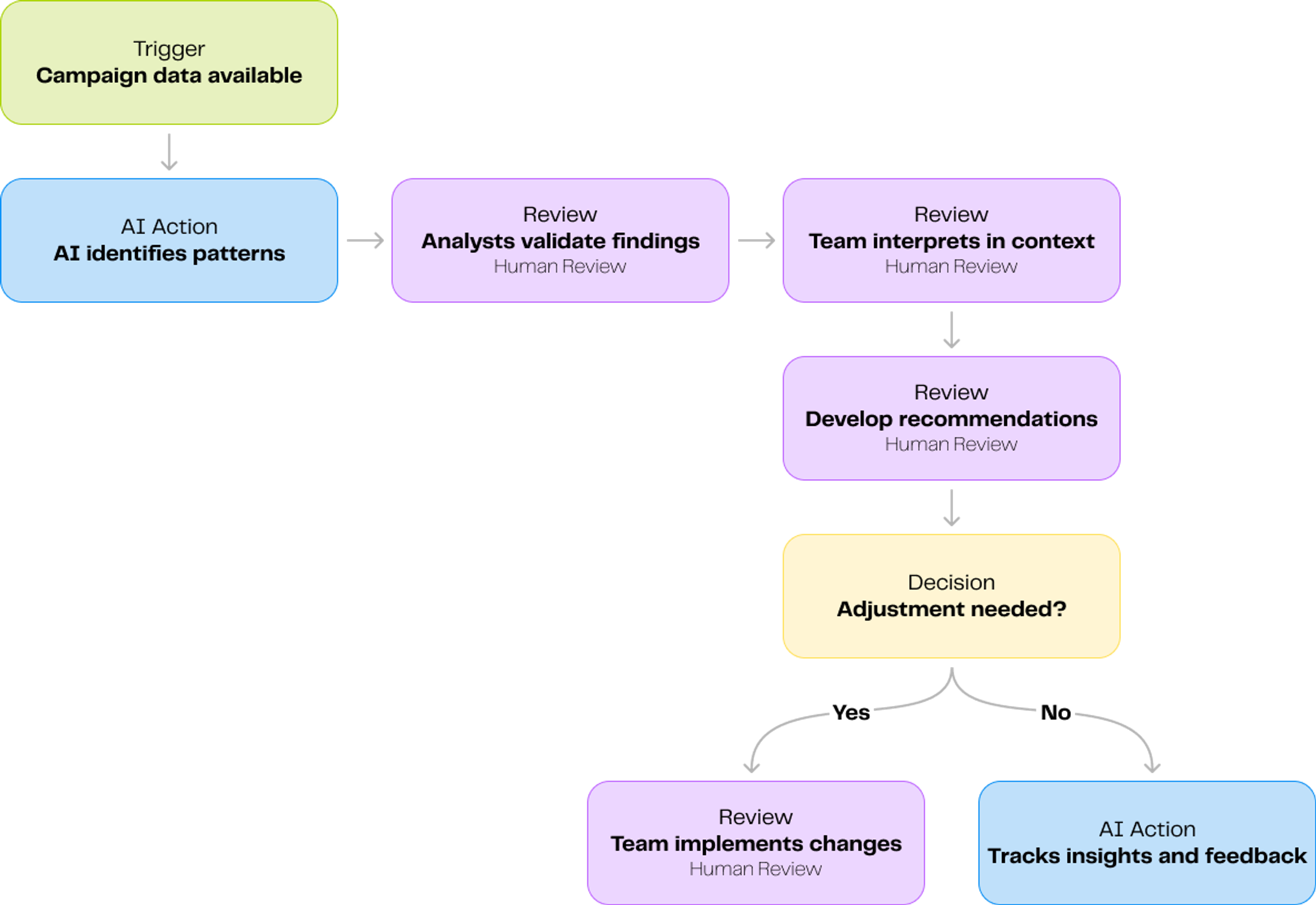
HITL enterprise case studies
Coca-Cola's Fizzion transforms design at scale
Coca-Cola operates one of the most complex marketing ecosystems in the world, with more than 200 brands in over 200 countries. Delivering locally resonant, on-brand creative at this scale has always been a challenge. Their answer is Fizzion, a design intelligence system developed with Adobe that transforms brand guidelines into intelligent, adaptive assets.
Fizzion works by learning from how designers operate inside Adobe Creative Cloud. As designers build layouts and make creative decisions, Fizzion captures that intent and encodes it into a StyleID, a machine-readable identity that automatically applies brand rules across formats and markets. Once trained, these StyleIDs enable teams to generate hundreds of localized campaign variations with precision. Designers remain fully in control, focusing on storytelling rather than formatting. The result is content production up to 10 times faster without compromising quality or brand integrity.
Starbucks personalizes at scale with Deep Brew
Starbucks uses Deep Brew, their AI engine that bridges personalized marketing with operational efficiency. The system analyzes customer behavior through app orders, preferences, and purchase history to generate marketing recommendations. Deep Brew identifies specific customer segments and their likely product interests by sifting through millions of data points.
The key to their approach is human oversight. Starbucks management reviews and implements AI outputs rather than letting the machine decide alone. Marketers set business goals, define parameters for the AI, and design the creative content of offers. They approve any AI-driven campaign to make sure it aligns with brand values. In the first quarter of 2024, Starbucks' 90-day active Rewards membership jumped 13% year-over-year, reaching 34.3 million members. Executives attributed this growth to successful targeted campaigns powered by Deep Brew analytics insights, with humans making those insights actionable.
Unilever's Beauty AI Studio delivers speed and quality
Unilever built a Beauty AI Studio to accelerate content creation across brands like Dove and Vaseline. The platform uses multiple large language models and image-generation models to create ad assets, with each brand having a custom "BrandDNAi" AI model encoding its style guidelines and regulatory constraints. This acts as an automated guardrail during content generation.
Humans remain firmly in the loop. Marketers and designers input creative prompts and use their market insights to steer AI output. All final creatives are reviewed by Unilever's marketers or agency partners before deployment. The company invested in training 25,000 employees in AI fluency so staff can effectively leverage and supervise these tools. The results are impressive: assets produced 30% faster, with video completion rates and click-through rates doubling for AI-generated ads versus previous creative.
Nike builds a personalized shopping assistant in three weeks
Nike built a fully functional AI-powered shopping assistant in 21 days that creates personalized shopping experiences through natural conversation. The assistant pulls from Nike's 170+ million loyalty member database and product catalog to surface relevant products in real-time and at scale.
The team built the initial proof-of-concept in eight days using publicly available product data and synthetic user data. They implemented monitoring tools that let non-technical staff oversee the AI without needing developers. The assistant leveraged three data sources: real-time conversation, member data, and enriched product catalogue embeddings.
They fine-tuned the model to return relevant products weighted by user preferences, making highly personalized recommendations possible. The system was designed for human oversight from day one, with detailed audit logs and controls that allowed teams to monitor, manage, and improve the assistant without replacing the strategic human judgment that makes personalization feel authentic.
Starting your own HITL experiments
The good news? You don't need some elaborate AI system to start experimenting with human-in-the-loop approaches. You already have the basics if you're using tools like ChatGPT or Claude.
The key is moving from individual use to systematic processes. Start small with something you're already doing manually. Pick one content type where AI could draft and humans refine. Test AI-generated subject lines with human curation before sending. Use AI for initial social listening analysis with human interpretation.
Make sure your foundations are solid. Clean data, clear brand guidelines, and teams trained to collaborate with AI effectively. These aren't massive infrastructure projects. They're organizational basics that pay dividends whether you're using AI or not.
The trial-and-error period is normal and valuable. Each experiment teaches you more about where AI adds value and where human judgment is non-negotiable. You'll get faster at recognizing the gap between AI output and brand-ready work, and you'll develop processes that close that gap efficiently.
Tools like Knak fit naturally into these workflows because they're designed for collaborative campaign creation with built-in brand guardrails. When you need to move from AI-generated concepts to actual deployments across channels, having systems that keep humans in the loop for review and approval becomes critical.











